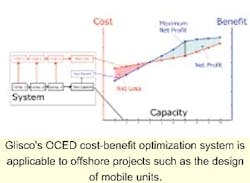SWEDEN Design and Cost Optimization: CAPEX assessment program offers widescale benefits to offshore sector
A new cost-benefit optimization system - OCED (Optimal Chief Executive Decision-maker) - has been developed by Glisco Optekon with the offshore industry intended as one of the target user groups. "OCED is based on the concept of cost-effective design, which is an objective way of adjusting complex systems to market needs in a cost-effective way," says Managing Director Nils Martensson. "It can be applied to systems in products, processes, organizations or invest-ments. They all have one thing in common, which is that it is very hard to decide where to put your money to get the highest profit."
The system provides a tool for handling the multiple interacting components which make up a process or a product. Taking input on costs and benefits over a range of capacities for each component, OCED generates cost/capacity and benefit/capacity curves for the whole product or process, thus making it possible to identify the capacity which generates the maximum net profit.
Workover vessel
The system has been used to optimize the automation of pill-packing production lines for pharmaceutical company AstraZeneca and for the risk evaluation and cost optimization of a methane gas tank system for car producer Volvo. Among its offshore references is a risk-based design assessment of the dynamic positioning (DP) and disconnect systems for a new design of workover vessel developed by Stena Drilling.
Starting from one component, Martensson says, all the other components making up the system can be optimized. In the mobile offshore drilling unit case, for example, taking the hull as the starting point, optimized characteristics can be calculated for the riser system, deck carrying capacity, drilling capability, and so on. In the context of an offshore vessel, the vessel motions and strength must obviously be accounted for, and to this end Glisco has developed the Bresp hydrodynamic program for analyzing the behavior of, and loads on, semisubmersible hulls. Once the platform data is entered, which is done within a few minutes, Bresp performs modeling in a few minutes and analysis in a few seconds.
The analysis can be extended to incorporate the operational phase, Martensson says, though here problems arise in forecasting market factors such as rig rates and usage which greatly reduces the reliability of income data. However, using OCED it is possible to calculate the sensitivities of different capacities to differing levels of income, thus giving the user an important tool for decision-making.
Platform removal
A second offshore-related assignment to which the program has been applied was a cost-benefit assessment to determine the optimal lifting capacity for Master Marine's proposed platform removal vessel, Master Mind. With a potential market of several hundred platforms of differing weights and sizes to be removed in the North Sea, and several thousand worldwide, it is important for designers of specialized abandonment vessels to be able to identify the optimal removal capacity.
A further potential application could also be of interest for the offshore market, Martensson says. This is to use OCED in project management to evaluate the impact of changes in important parameters, such as altered process capacity in a production platform. Here the effect of such a change on other components in the project can be analyzed, and the likely effects on project schedule and cost calculated.
For more information, contact Nils Martensson, Glisco, tel: +46 31 711 61 80, fax: +46 31 708 79 00, e-mail: [email protected].

